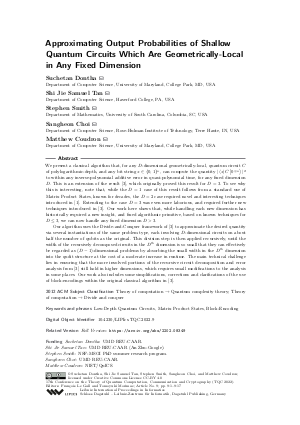Approximating Output Probabilities of Shallow Quantum Circuits Which Are Geometrically-Local in Any Fixed Dimension
Authors Suchetan Dontha, Shi Jie Samuel Tan, Stephen Smith, Sangheon Choi, Matthew Coudron
-
Part of:
Volume:
17th Conference on the Theory of Quantum Computation, Communication and Cryptography (TQC 2022)
Part of: Series: Leibniz International Proceedings in Informatics (LIPIcs)
Part of: Conference: Conference on the Theory of Quantum Computation, Communication and Cryptography (TQC) - License:
 Creative Commons Attribution 4.0 International license
Creative Commons Attribution 4.0 International license
- Publication Date: 2022-07-04
File

PDF
LIPIcs.TQC.2022.9.pdf
- Filesize: 0.81 MB
- 17 pages
Document Identifiers
Related Versions
- Full Version https://arxiv.org/abs/2202.08349
Subject Classification
ACM Subject Classification
- Theory of computation → Quantum complexity theory
- Theory of computation → Divide and conquer
Keywords
- Low-Depth Quantum Circuits
- Matrix Product States
- Block-Encoding
Metrics
- Access Statistics
-
Total Accesses (updated on a weekly basis)
0PDF Downloads0Metadata Views
Abstract
We present a classical algorithm that, for any D-dimensional geometrically-local, quantum circuit C of polylogarithmic-depth, and any bit string x ∈ {0,1}ⁿ, can compute the quantity |<x|C|0^{⊗ n}>|² to within any inverse-polynomial additive error in quasi-polynomial time, for any fixed dimension D. This is an extension of the result [Nolan J. Coble and Matthew Coudron, 2021], which originally proved this result for D = 3. To see why this is interesting, note that, while the D = 1 case of this result follows from a standard use of Matrix Product States, known for decades, the D = 2 case required novel and interesting techniques introduced in [Sergy Bravyi et al., 2020]. Extending to the case D = 3 was even more laborious, and required further new techniques introduced in [Nolan J. Coble and Matthew Coudron, 2021]. Our work here shows that, while handling each new dimension has historically required a new insight, and fixed algorithmic primitive, based on known techniques for D ≤ 3, we can now handle any fixed dimension D > 3.
Our algorithm uses the Divide-and-Conquer framework of [Nolan J. Coble and Matthew Coudron, 2021] to approximate the desired quantity via several instantiations of the same problem type, each involving D-dimensional circuits on about half the number of qubits as the original. This division step is then applied recursively, until the width of the recursively decomposed circuits in the D^{th} dimension is so small that they can effectively be regarded as (D-1)-dimensional problems by absorbing the small width in the D^{th} dimension into the qudit structure at the cost of a moderate increase in runtime. The main technical challenge lies in ensuring that the more involved portions of the recursive circuit decomposition and error analysis from [Nolan J. Coble and Matthew Coudron, 2021] still hold in higher dimensions, which requires small modifications to the analysis in some places. Our work also includes some simplifications, corrections and clarifications of the use of block-encodings within the original classical algorithm in [Nolan J. Coble and Matthew Coudron, 2021].
Cite As Get BibTex
Suchetan Dontha, Shi Jie Samuel Tan, Stephen Smith, Sangheon Choi, and Matthew Coudron. Approximating Output Probabilities of Shallow Quantum Circuits Which Are Geometrically-Local in Any Fixed Dimension. In 17th Conference on the Theory of Quantum Computation, Communication and Cryptography (TQC 2022). Leibniz International Proceedings in Informatics (LIPIcs), Volume 232, pp. 9:1-9:17, Schloss Dagstuhl – Leibniz-Zentrum für Informatik (2022)
https://doi.org/10.4230/LIPIcs.TQC.2022.9
BibTex
@InProceedings{dontha_et_al:LIPIcs.TQC.2022.9,
author = {Dontha, Suchetan and Tan, Shi Jie Samuel and Smith, Stephen and Choi, Sangheon and Coudron, Matthew},
title = {{Approximating Output Probabilities of Shallow Quantum Circuits Which Are Geometrically-Local in Any Fixed Dimension}},
booktitle = {17th Conference on the Theory of Quantum Computation, Communication and Cryptography (TQC 2022)},
pages = {9:1--9:17},
series = {Leibniz International Proceedings in Informatics (LIPIcs)},
ISBN = {978-3-95977-237-2},
ISSN = {1868-8969},
year = {2022},
volume = {232},
editor = {Le Gall, Fran\c{c}ois and Morimae, Tomoyuki},
publisher = {Schloss Dagstuhl -- Leibniz-Zentrum f{\"u}r Informatik},
address = {Dagstuhl, Germany},
URL = {https://drops.dagstuhl.de/entities/document/10.4230/LIPIcs.TQC.2022.9},
URN = {urn:nbn:de:0030-drops-165163},
doi = {10.4230/LIPIcs.TQC.2022.9},
annote = {Keywords: Low-Depth Quantum Circuits, Matrix Product States, Block-Encoding}
}
Author Details
- Department of Computer Science, Rose-Hulman Institute of Technology, Terre Haute, IN, USA
Funding
- Dontha, Suchetan: UMD REU-CAAR.
- Tan, Shi Jie Samuel: UMD REU-CAAR (An Zhu-Google).
- Smith, Stephen: NSF-MSGI PhD summer research program.
- Choi, Sangheon: UMD REU-CAAR.
- Coudron, Matthew: NIST/QuICS.
Acknowledgements
MC thanks Sergey Bravyi for helpful discussions. We thank Gorjan Alagic and Nolan Coble for attending and contributing to some project group meetings. We thank the REU-CAAR program (NSF grant number 1852352) which funded SD, SJST, SC over the summer of 2021.
References
- Sergy Bravyi, David Gosset, and Ramis Movassagh. Classical algorithms for quantum mean values. QIP, 2020. URL: http://arxiv.org/abs/1909.11485.
- Michael J. Bremner, Richard Jozsa, and Dan J. Shepherd. Classical simulation of commuting quantum computations implies collapse of the polynomial hierarchy. Proc. R. Soc. A., 467:459-472, 2010. URL: https://doi.org/10.1098/rspa.2010.0301.
-
Nolan J. Coble and Matthew Coudron. Quasi-polynomial time approximation of output probabilities of geometrically-local, shallow quantum circuits. In 62nd Annual Symposium on Foundations of Computer Science, FOCS 2021, 2021.

- András Gilyén, Yuan Su, Guang Hao Low, and Nathan Wiebe. Quantum singular value transformation and beyond: exponential improvements for quantum matrix arithmetics. STOC, 2019. http://arxiv.org/abs/1806.01838.
- Yasuhiro Kondo, Ryuhei Mori, and Ramis Movassagh. Fine-grained analysis and improved robustness of quantum supremacy for random circuit sampling, 2021. URL: http://arxiv.org/abs/2102.01960.
- Ramis Movassagh. Quantum supremacy and random circuits. QIP, 2020. http://arxiv.org/abs/1909.06210.
- Barbara M. Terhal and David P. DiVincenzo. Adaptive quantum computation, constant depth quantum circuits and arthur-merlin games. Quantum Inf. Comput., 4(2):134-145, 2004. URL: https://doi.org/10.26421/QIC4.2-5.
